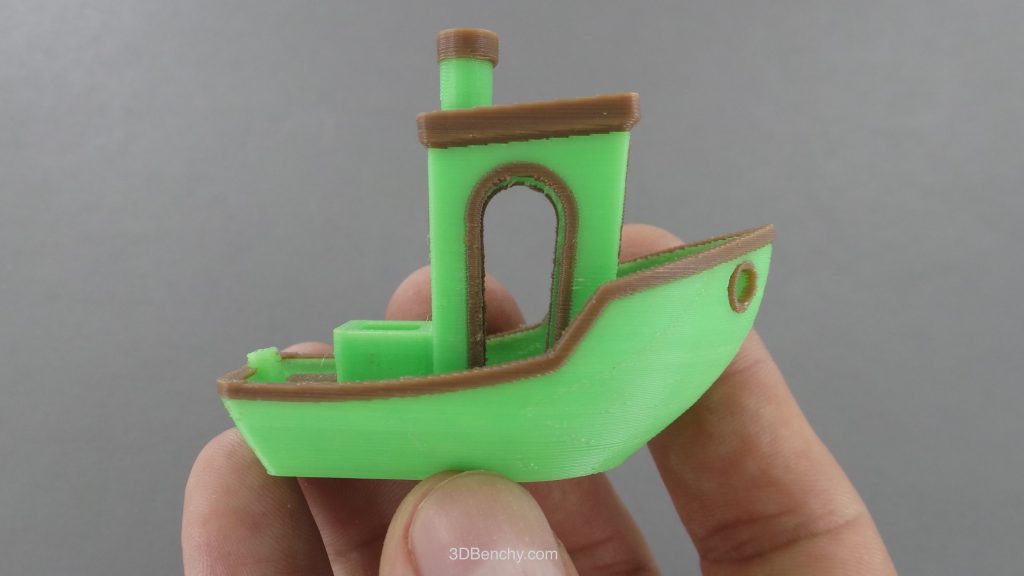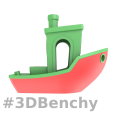
#3DBenchy, the tiny boat initially designed for internal testing purposes at the Swedish 3D solutions provider Creative Tools, is now the most 3D-printed model in the world. This bold statement might be a bit over-the-top, but it does have some truth to it.
Recently, #3DBenchy became the design with the most number of makes on the popular file-sharing site Thingiverse.com. If you’re new to this, a “make” occurs when a user on Thingiverse posts a photo of a 3D printed part which is created by someone else. It is a way for anyone to honour a designer by saying: “Hey, check out my printed result of the file you shared”.
It is a valid assumption that only a small fraction of the 3D printed files from Thingiverse gets “makes”, and of course, that goes for any design on other similar file-sharing sites, of which there are many. The number of makes, therefore, only reflects the “tip of the iceberg” regarding the real-world number of 3D-prints.
Thingiverse.com is probably the most – or arguably one of the most popular – file-sharing sites focusing on designs for 3D printing. According to Thingiverse’s internal statistics, #3DBenchy is the most popular design on the site, almost twice as popular as the next ranking design. (Please refer to the end of this article for detailed statistics.)
Motivation and Background
So, how did all this happen? Creative Tools is an established reseller offering 3D software, hardware, services and training. The regular customer base includes companies working in areas such as architecture, game development, VFX, animation, product design, as well as enthusiastic individuals digging into the world of 3D.
As part of the company’s hardware business, the team at Creative Tools performs extensive testing of various 3D printer models, materials and software settings. This process of evaluation enables the company to fully understand market-established machines, as well as new 3D printing hardware. The accumulated know-how then serves as the base of Creative Tools’ troubleshooting and customer support.
Inevitably, extensive testing of various aspects of 3D printing, yields a high number of sample parts, creating a mound of discarded models ranging in different sizes and shapes. Therefore, back in 2014, internal discussions started around the need to simplify the testing process by creating a single and unique multi-purpose test model for evaluating and comparing different printers, materials and slicers.
In early 2015, the CAD team at Creative Tools got the assignment to develop such a model. The task consisted of creating a single 3D file containing as many features as possible, including a variety of measurable geometric and organic shapes, to challenge the capabilities and reveal limitations of 3D printers.
Testing Criteria
Operators of 3D printers need time and patience while testing a machine and its settings. Therefore, the design team at Creative Tools defined the following set of criteria for making the new benchmark file as easy-to-print as possible but simultaneously posing a challenge to 3D printing hardware and software.
Measurable
The part should be easy to measure using a caliper tool, making the resulting dimensions valuable for calibrating the 3D printer hardware, firmware and the slicing software.
Recognisable
Taking into account that design affects how an object is perceived, the team had the task to combine the shapes into something that anyone could easily recognise – and if possible, it should be a “cute” thing to 3D print.
As an added benefit, an appealing shape extends the life of a 3D printed part as decorative desktop toy or giveaway. Noticeably, it didn’t take long for fleets of colourful #3DBenchy boats to appear as makes on Thingiverse and other social media.
Print and Material Consumption
A typical test should take roughly sixty minutes, meaning that benchmarking would be relatively fast and consume reasonable amounts of material.
The Design Process
Simply put, the goal was set to create a model that would contain as many features as possible, be something recognisable and 3D-print in about hour.
The part was 3D-modelled in CAD software making sure the original surfaces would be accurate and not “suffer” from any predefined triangular tessellation – which is a known issue regarding low-resolution STL files.
So in early spring 2015, the design team rolled up their sleeves and started the process. After several iterations, a tiny boat came to life, and it was soon named #3DBenchy.
The STL and Print-File as Troubleshooting Tools
The fundamental principle for using #3DBenchy is straightforward. The customer and the support team at Creative Tools 3D print the same STL-file using equivalent software, material and 3D printer models.
By comparing photos of the printed parts, any deviation is made distinctly visible, thus revealing the cause of the problem. As a positive consequence, it was apparent that it is more efficient to attach JPEG files to a support ticket conversation than to ship an entire 3D printer to the Creative Tools’ service centre. This process revealed the most obvious advantage of using #3DBenchy – it grew to be a time-saving tool!
After sending the #3DBenchy STL file to customers, it became evident that providing optimised ready-made print-files, significantly improved troubleshooting. Since most 3D printers can print directly from a USB stick or SD card, Creative Tools now supplies pre-sliced print files of #3DBenchy for each 3D printer model and material choice.
In this manner, the customer only needs to download the print file and copy it onto the machine’s memory-card to initiate the print. Theoretically, if the 3D printer, its firmware and materials are equivalent, two identical printed parts will be made – on the customer’s machine and at Creative Tools. By comparing both photos, the support team can then quickly and reliably advise the customer on how to adjust the hardware, material conditions and software settings.
Sharing the Progress with the Community
Creative Tools released the model publicly on April 9th, 2015 as an effort to share #3DBenchy as a tool for the 3D printing user base. It also quickly helped to expand the testing-base for #3DBenchy to a worldwide audience, thus creating a more substantial benchmarking dataset.
As a part of the efforts to spread #3DBenchy, Creative Tools officially presented it at the London 3D Printing Show that year. Since then, numerous boats have been 3D printed by a wide variety of sources, ranging from 3D printer manufacturers to slicing software developers and the vast 3D printing community.
The adoption of #3DBenchy as a standard benchmarking part is also noticeable as the model is now shipped pre-sliced on several 3D printer models.
The Gratitude to the 3D Printing Community
For the team at Creative Tools, it has been a pleasant process to see how the community embraced the tiny boat which was initially just intended to be an internal testing tool and made it into a universal open 3D printing success!
Without the effort of all the many enthusiasts and professionals, #3DBenchy would not have reached so many build plates around the world.
Statistics on Thingiverse.com
As the time of writing, the #3DBenchy file has the following metrics on Thingiverse.com.
-
- Likes: 14,819
-
- Collects: 19,702
-
- Comments: 222
-
- Makes: 2,029
-
- Watch: 231
-
- Views: 694,702
- Downloads: 345,217
A big thank you should also be directed to the team behind Thingiverse.com for providing the following detailed statistics about #3DBenchy.
-
- #1 overall Thingiverse stats combined
-
- #1 in downloads
-
- #1 in collections
-
- #1 in makes
-
- #4 in views
- #7 in likes
There are currently 1.5 million members and around 1.8 million designs on Thingiverse.com.
